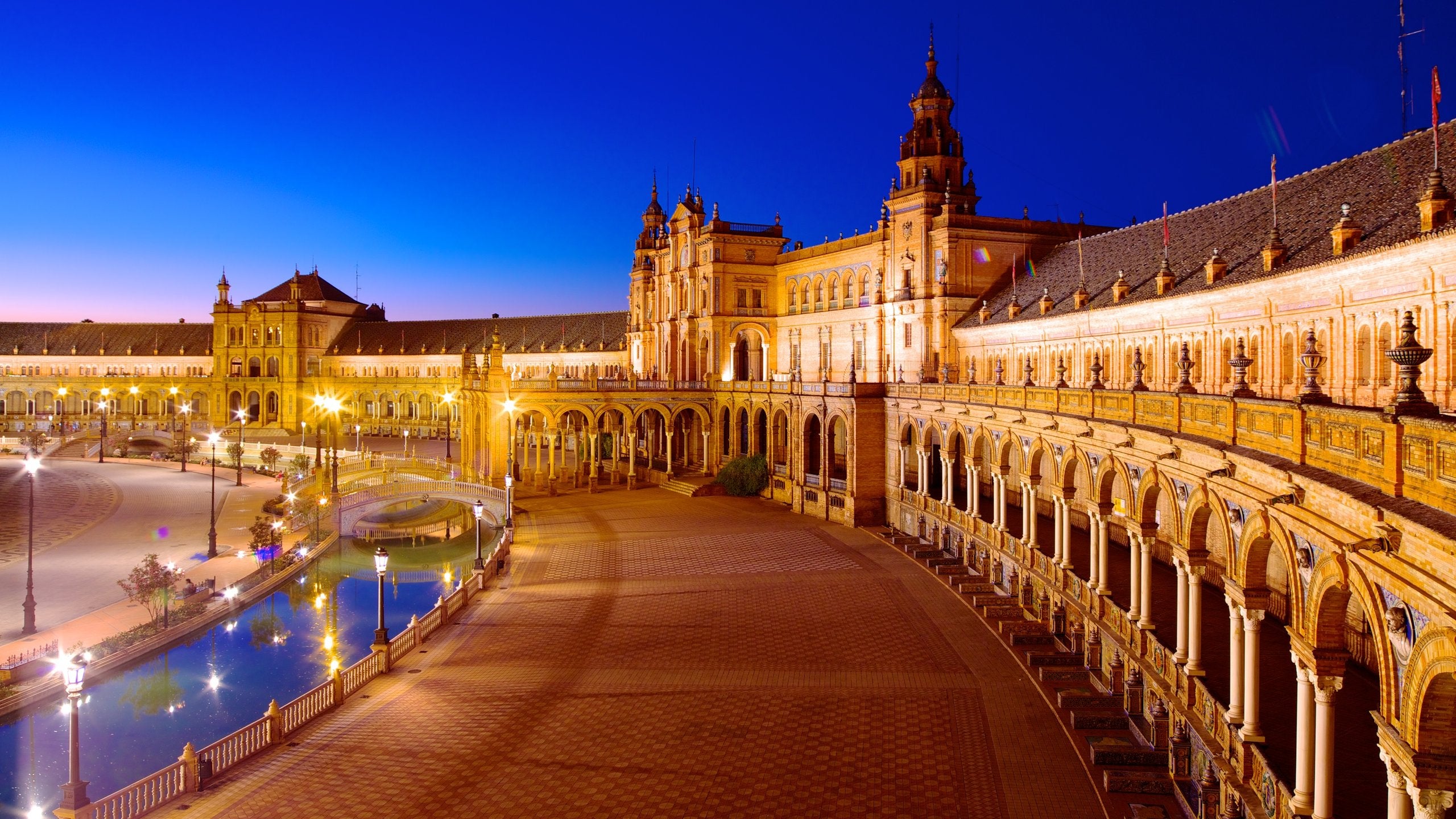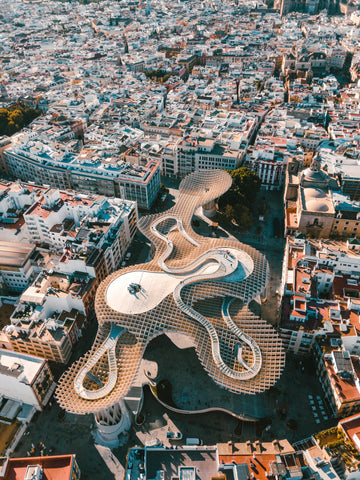
Sevilla
Whether you’re heading to Seville to indulge in the centuries-old festivities during the Holy Week, a big game, or to stroll through picturesque plazas before treating yourself to an assortment of tapas, there’s much more to this artistic city than meets the eye.

The largest city in Southern Spain, Seville is said to be built by Hercules himself. With architectural masterpieces, flamenco dancing, and its historic football clubs, Seville is one of the most intriguing cities in the world to explore.
Before we can appreciate the rich culture permeating through the city’s walls, it’s essential to visit Seville’s relics, its iconic structures, and the mythos that make this destination one for the wish list.
Herculean Roots
We love a good legend, so let’s start with Hercules. A Greek demi-god known for his strength, many believe Hercules established the city before passing it down to his son, Hispano. Under Hispano’s rule, the city earned its original name: Hispalis. 
Perhaps the more credible theory describes a Tartessos community living in the Guadalquivir valley, which was later inhabited by Phonecians, Greeks, and Carthaginians. During the Second Punic War in 205 BC, the settlement fell victim to Roman rule, where it stayed for two centuries.
A name change came in 43 BC when Julius Caesar took over the city, calling it Lulia Romuela, or Romuela. This age marked the rise of the city to a vital part of the Roman province of Hispania Baetica. All powerful things must come to an end, though, and Silingi vandals staked their claim on Romuela when the Roman Empire fell.
Soon after the Silingi occupation, the Visigoths took over and made the city their kingdom’s capital. If you’re a Game of Thrones fan, you’ll be able to envision a notable banquet reminiscent of the “Red Wedding” called the “supper of candles.” During the event, Sevillian nobles took cover after blowing out the candles in the room and killed Gothic King Theudigisel.
While the capital was moved shortly after to Toledo, Saint Leandro and Saint Isidoro retained Seville’s significance, cementing their image alongside King Ferdinand III on Seville’s emblem. In the year 712, the city was overcome by Abd al-Aziz ibn Musa and renamed Isbiliya, from which the city’s current name is derived.
During what was called the Almohad Dynasty beginning in 1091, Seville hit its stride. It was during this period, with new architectural developments, art, and a surging population, the city thrived until the Great Plague of 1649, which diminished half of Seville’s residents. With great struggle comes great beauty, though, and notable artists emerged during this time—including the likes of Valdés Leal and Martínez Montañés.
Many of Seville’s emblematic structures were conceived during these years, and they’re worth observing. According to www.veebrant.com, Santa María de la Sede (as it is officially known) was built during the Reconquest on the site of a 12th-century Islamic mosque and is the largest Gothic cathedral in the world. It is also one of Spain’s most treasured monuments. Another stunning architectural wonder, the Alcázar of Seville blends Moorish, Gothic, Mudéjar, and Renaissance elements, and is an international treasure spanning a lifetime of development for over 11 centuries.
Read more about Spain: Madrid – Spanish Gem
Seville's Food Scene

Beyond tapas, Spain is known as a haven for foodies, and Seville is no exception to the rule. Like most Spanish cuisine, pork plays a main role in many popular dishes. Carrillada de cerdo is a very traditional Sevillian meal made with pork cheek, cooked low and slow, in a simple wine reduction. If made well, it is tender, juicy, and meant to be enjoyed with a glass of BIG red Spanish wine. Though the region is known for their sherry, we’d recommend a bold Priorat.
A go-to found virtually anywhere in Seville is the city’s signature sandwich, the serranito. Perfect street or pub food, the serranito is seared pork loin topped with an aged, salty slice of serrano ham, tomato and a grilled green pepper, served in a crusty homemade baguette.
With its rich, blended cultural past, many Moorish spices can be found in many traditional dishes. A marinade of cumin, oregano, vinegar and lemon is used to make fried fish nuggets - typically made of sand shark. And if you love gazpacho, salmorejo will be a favorite for you. Although made with less ingredients, it’s perhaps salmorejo’s simplicity that makes it so addictive, especially on a hot Seville night. It’s easy to fall in love with this city for its food alone, but its architectural beauty is the shining star.
Iconic Structures

A city’s structures tell a story, and there’s nothing like the narrative Seville’s architecture paints for visitors and longtime residents alike. When strolling through the center of Seville, you’ll pass by some of the most influential buildings from the 16th century. The Cathedral, General Archive of the Indies, Town Hall, Casa de la Moneda, and Castile’s first printing press are all historic spots in the heart of Seville.
Following some of the classics, in 1728 the newly-built Royal Tobacco Factory set the stage for Seville’s economic success. Another cultural fixture is the Plaza de Toros, which may be a touchy subject for some, but “The Bullring” arena boasts baroque stylings and impressive acoustics fit for 14,000 spectators. It was built somewhere between 1762 and 1881, and still hosts beastly battles today.

Tying together the intricate aesthetics and fortitude of Seville was the Ibero-America Exhibition of 1929. The event intended to shape the world’s view of the city, and it was exceedingly successful. To supplement the exhibition’s attractions, Museo Arqueológico de Sevilla was built within a stunning pavilion for visitors to explore.
With artifacts dating back to the Phoenicians, Romans, and Tartesians, the museum is home to notable pieces like the statue of Venus de Itálica. It also houses remnants of crowns and necklaces traced to the 6th century, discovered in 1958.
And, of course there is the pièce de résistance, established 24 years before the Ibero-America Exhibition made its debut, was the formation of the city’s oldest football club: Sevilla FC. Formed in 1890, it was in 1905 that its formal articles of association were filed.
Read more football history: Top 10 Number 10s in Football History
Sevilla FC
Sevilla FC was not just a sporting association—it was also a private cultural institution, formed in 1890. With changes in legislation, the club was officially allowed to register in 1905. In-country rivals of Real Madrid, FC Barcelona, Valencia CF, and Atlético de Madrid, Sevilla FC holds a fifth-place spot in terms of national titles and a sixth-ranked position on the all-time league table.

The following are Sevilla FC’s most noteworthy wins:
● One La Liga title
● Five Spanish Cups
● Six Europa League titles
● European Super Cup
● Spanish Super Cup
In 2006 and 2007, Sevilla FC was regarded as the best team in the world by the International Federation of Football History and Statistics. The historic club has also churned out some formidable players in the league. Jesús Navas and Álvaro Negredo were just two of 37 players integrated into the Spanish national team.

Not only were Navas and Negredo champions on the national team, but Navas also played a role in the 2010 World Cup win. The pair even played alongside each other in the 2012 European Cup.
Real Betis Balompié
But alas, Sevilla FC isn’t the only game in town… With almost as long a history as Sevilla FC, Real Betis Balompié was founded in 1907, under the name of Sevilla Balompié by young medical students. In 1914, the club was merged with Betis Football Club, an offshoot of Sevilla FC. Since then, the club has been known as Real Betis Balompié. A resilient club, and one that is adored by their fans, Real Betis Balompié is the only team to hold titles in the First, Second and Third Divisions.
As a city thought to be formed by Herculean strength, it’s clear that Seville will remain a force to be reckoned with for years to come. With sites deeply rooted in resilience and innovation, a celebratory culture, and feisty football clubs, we can see why you’d want to pack up your Rimet Passport Book and add Seville to your list of must-see cities.
Join us. Click here to visit our growing collection today!
Be a TENLEGEND®.
